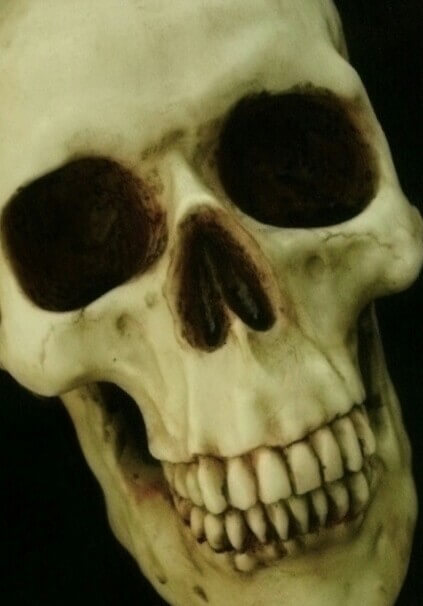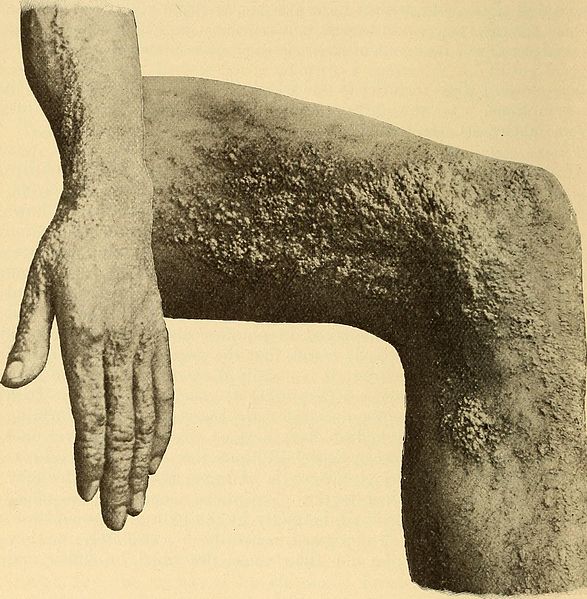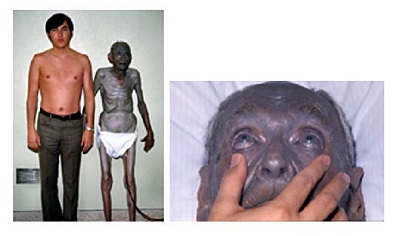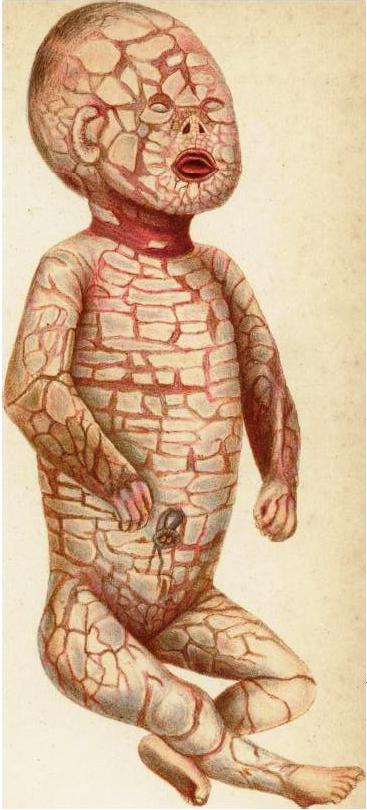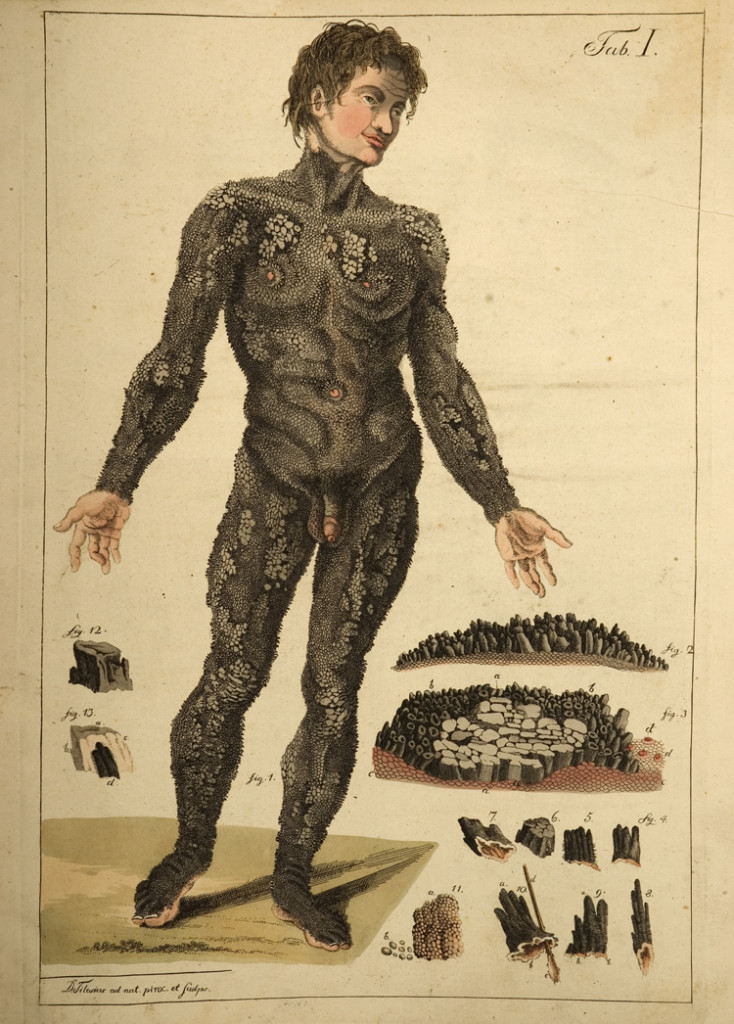We are about to share 10 weird skin diseases in humans. But before we go any further, we must warn you that some of the pictures of these disorders are immensely gruesome. So if you have a weak stomach, this is not the post for you.
This post was updated by Trina McMillin (author profile).
The skin is the largest organ in the human body. It serves vital functions that are crucial to the survival of the human race. Unfortunately, humans can acquire diseases that can cause physical and mental suffering, and even death. In previous posts we covered skin diseases such as Darier’s disease, and monkeypox. Here are ten more you won’t believe actually exist.
A List Of Skin Conditions You Won’t Believe Are Real
#1 A Case Of Massive Keloids

“Massive Keloids” by Htirgan is licensed under CC BY-SA 3.0
A Keloid is an abnormal proliferation of scar tissue. It is formed at the site of either a scar or a injury. The scars are caused by an overgrowth of granulation tissue at the site of a healed skin injury. Example: On the site of a surgical incision or trauma. Skin injury types such as acne scars, burns, surgical incisions, ear piecing and even scratches can are contributors to keloid scarring.
Fortunately, keloid scars are not contagious nor malignant (cancerous). Sufferers may experience painful (a needle-like pain) and severe itchiness. The scars have been seen more frequently in highly pigmented ethnic groups including African Americans, Asians and Hispanics. If one or both of your parents happen to suffer with keloid scars, chances are higher that you will also have them.
Interestingly, keloid scars were first described by Egyptian surgeons around 1700 BC.
Treatment: Sufferers are advised to prevent unnecessary trauma or surgery. This even includes ear piercing and mole removal. Also, early treatment of acne (if necessary) is recommended. However, treatment for the removal of a keloid is an effective procedure called superficial external beam radiotherapy (external beam radiotherapy directing the radiation at the site of the tumor).
#2 Fournier Gangrene
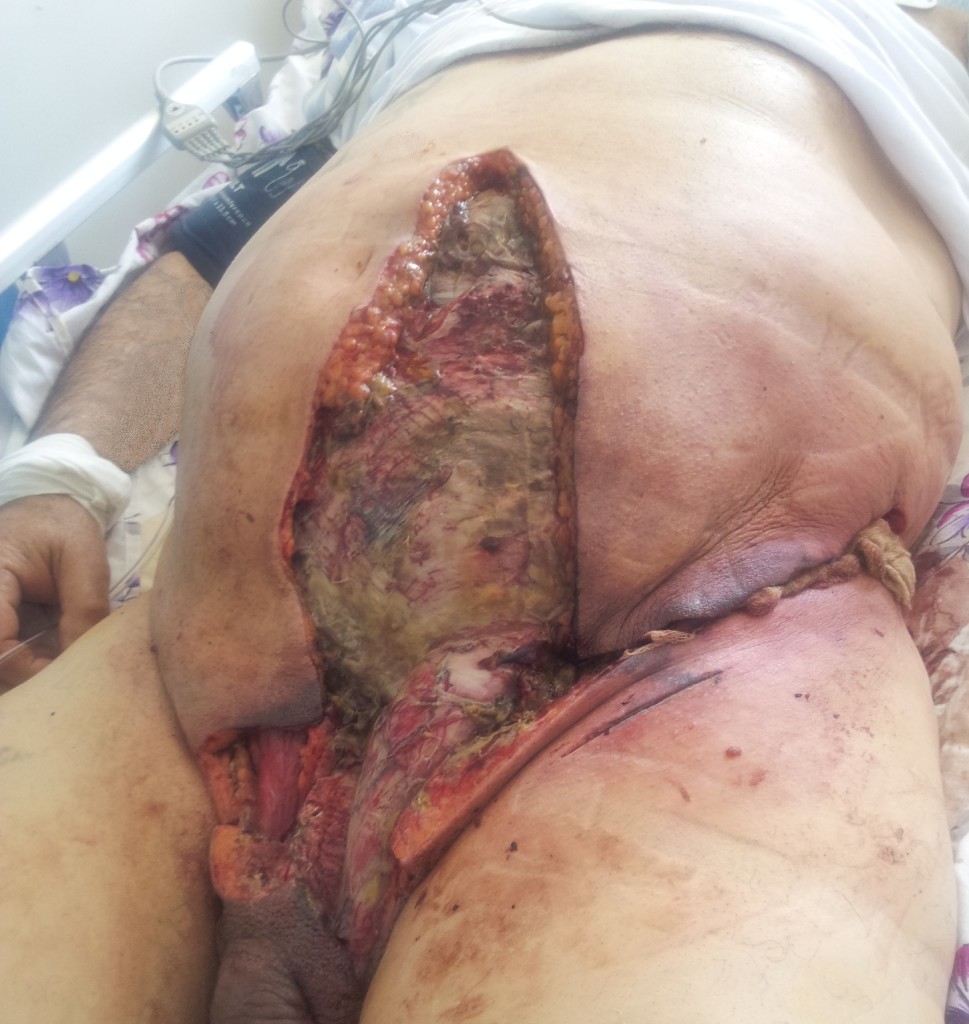
“Fournier’s Gangrene” by Hayk Margaryan is licensed under CC BY-SA 3.0
Fournier’s gangrene is a type of gangrene that usually affects the perineum. The condition can be life-threatening. In most cases, it is caused by both aerobic and anaerobic bacteria. According to a study that was performed back in 2000, only 1726 cases have been reported in English literature.
Treatment: Requires intravenous antibiotics and surgery to remove the dead tissue. Patients may also be treated with Hyperbaric medicine to help kill and prevent the growth of anaerobic bacteria.
A Gangrene Foot
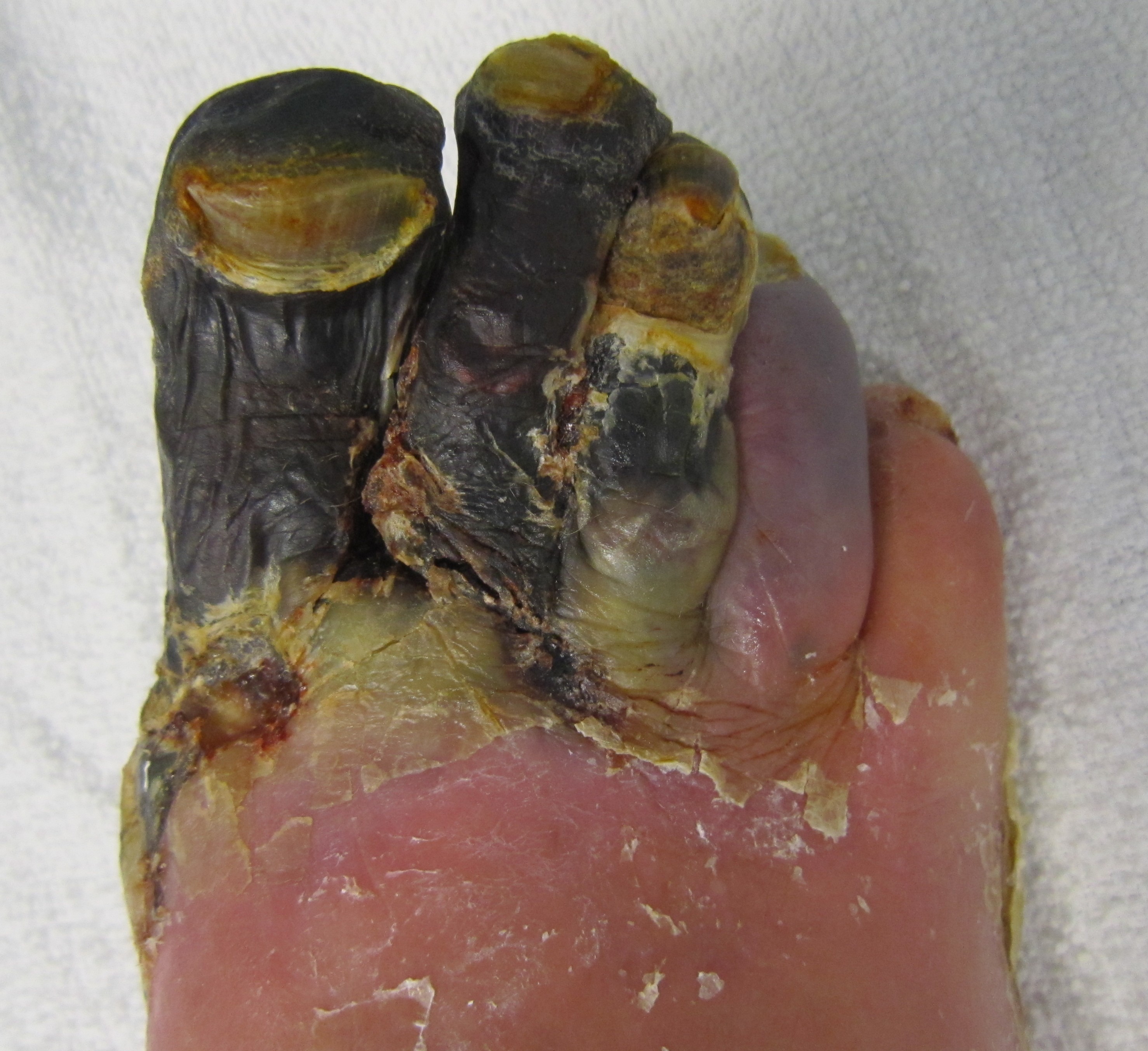
“Gangrene Foot” by James Heilman, MD is licensed under CC BY-SA 3.0
#3 Acanthosis Nigricans
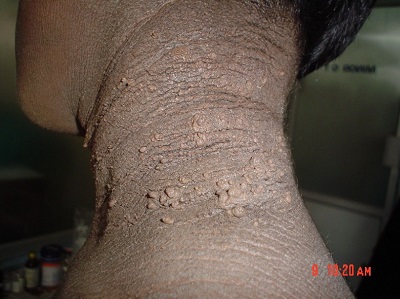
“Acanthosis Nigricans” by Vandana Mehta Rai MD DNB, C Balachandran MD is licensed under (CC BY-SA 3.0)
Acanthosis nigricans generally develops on the knees, elbows, armpits and knuckles. Although this condition will not cause additional problems, it can be a sign of existing issues. Possible issues include diabetes, obesity, a drug reaction, hormone imbalances and/or cancer. In addition to creating an itch, these thick, dark and velvety patches of skin tend to emit a foul odor.
Treatment Options:
Since acanthosis nigricans is a symptom of an existing issue, the issue that is causing the problem will need to be addressed.
Cosmetic treatments include antibacterial soaps, skin lighteners, laser therapy and oral acne medications. While these treatments will improve the appearance of the areas affected, they are not able to cure the condition.
#4 Argyria
Argyria, which is also referred to as argyrosis, is a condition caused by silver buildup within the tissues. An individual with argyria has a purple/bluish-gray skin tone. Sunlight may worsen this condition.
The purple/bluish-gray skin tone is caused by excessive exposure to silver dust or the chemical compounds of the element silver, including consumption of the dietary supplement colloidal silver, can cause argyrosis. Unfortunately, this condition is typically permanent.
If an individual has generalized argyria, large areas of the body are affected; whereas, local argyria only affects limited regions. For example, the mucous membrane covering the front of the eye (conjunctiva) and/or random patches of skin may be affected. The use of eye drops containing silver can lead to localized argyrosis of the eye; however, generalized argyria occurs due to the habitual swallowing or inhaling of silver compounds.
Treatment: There is no cure for argyria; however, laser treatments are showing promise in reducing the skin discoloration associated with this condition.
#5 Post Burn Hand Deformity
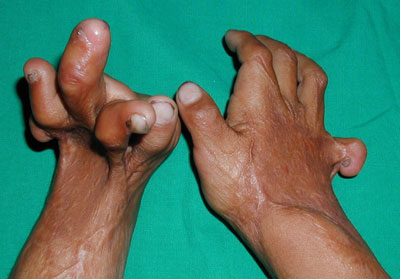
“Verbrennungsnarbe Hand” by Dr. Andreas Settje under CC BY-SA 3.0
The above image shows a patient that suffered with a severe post burn hand deformity. A burn scar contracture is when the skin begins to pull together following a second or third degree burn. If the burn is not treated in time, the scar may eventually restrict the movement around the injured area. Similar to a hand deformity from X-ray burns, the severe burns lead to restricted movement. The hand has been ranked as one of the most frequent sites of burn scar contracture deformity.
Treatment: Quick and appropriate treatment is recommended to help prevent a scar from resulting in the restriction of movement. The patient may need the contracture to be released. Other treatments include physiotherapy, splinting, skin grafting and drug-store treatments (such as silicone gel treatments) to help scar maturation. Surgery may be performed with reconstructive procedures. The surgery can provide results that may help improve the functioning of the hands.
#6 Cutaneous Horn On Right Pinna
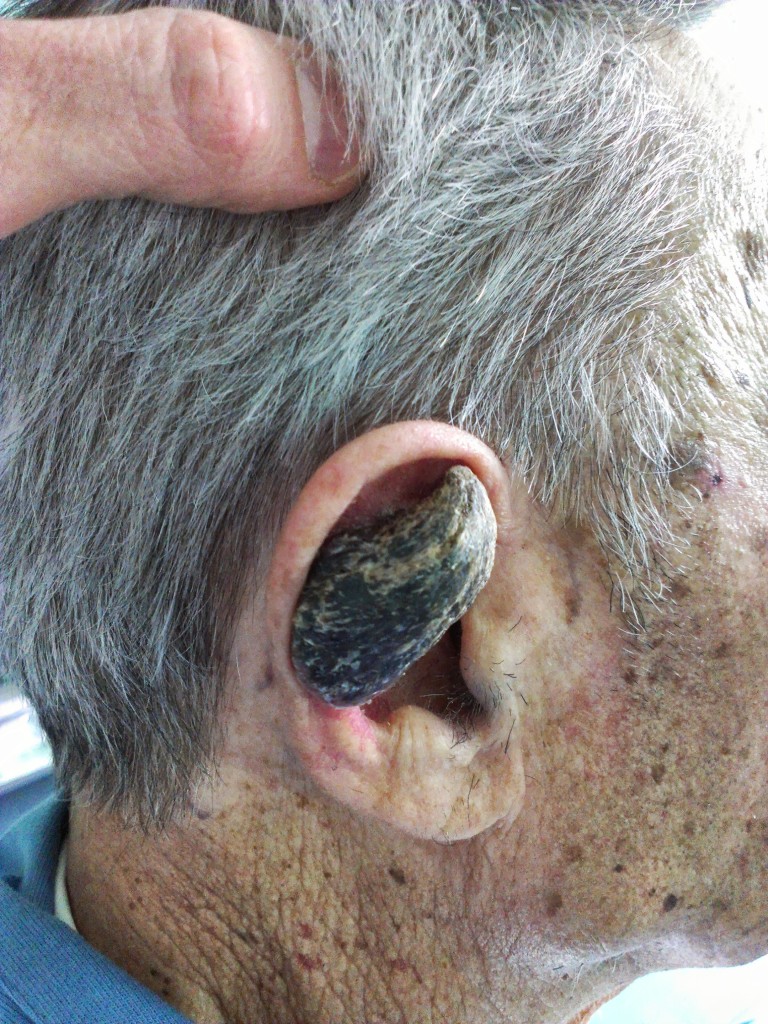
“Cornu Cutaneum” by Jojo is licensed under CC BY-SA 3.0
Cutaneous horns are very rare keratinous skin tumors. They are usually benign, but can also be premalignant (precancerous) or malignant. Although the cutaneous horns are typically small and localized, there have been some rare cases where they have become much bigger (like image).
Interestingly, there is still no known cause of cutaneous horns. However, it is believed that the exposure to radiation, as well as burn scars can potentially help trigger the rise of the condition.
Treatment: Due to the fact that a horn is made of keratin (a fibrous structural protein that is found in fingernails), it may be removed with a sterile razor. However, the underlying condition still needs to be treated. The treatments include radiation therapy, chemotherapy and surgery.
A prominent case of cutaneous horns is a 101-year-old woman by the name of Zhang Ruifang. She grew a horn on her forehead. It reached a total length of 6 centimeters. Ruifang also has another one forming on the opposite side of her forehead. Her family has given her the nickname “Devils Horns.”
#7 Onychogryphosis “Ram’s Horn Nails”
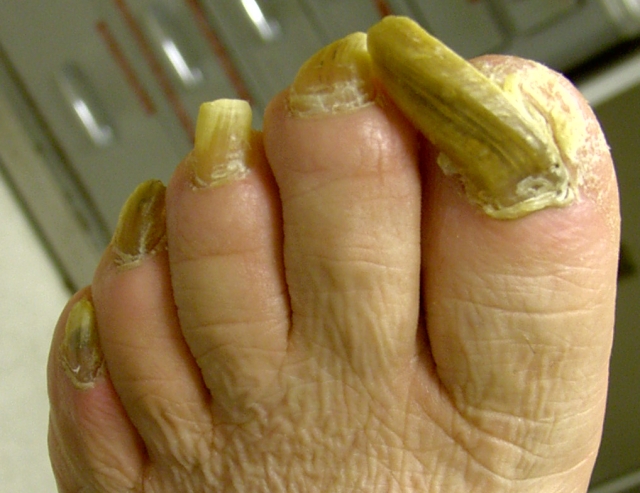
“ONYCHOGRYPHOSIS” by Drgnu23 is licensed under CC BY-SA 3.0
Onychogryphosis, or “Ram’s Horn Nails” is a nail abnormality with hypertrophy (enlargement of an organ or tissue) that is capable of producing nails that resemble ram’s horns. It is most commonly seen in the elderly and is usually secondary to self-neglect and failing to cut the nails for long periods of time. However, it can also be caused by peripheral artery disease (PAD) or even trauma.
Treatment: Some surgeons recommend a procedure that involves the avulsion of the nail plate.
Onychogryphosis In An Elderly Male
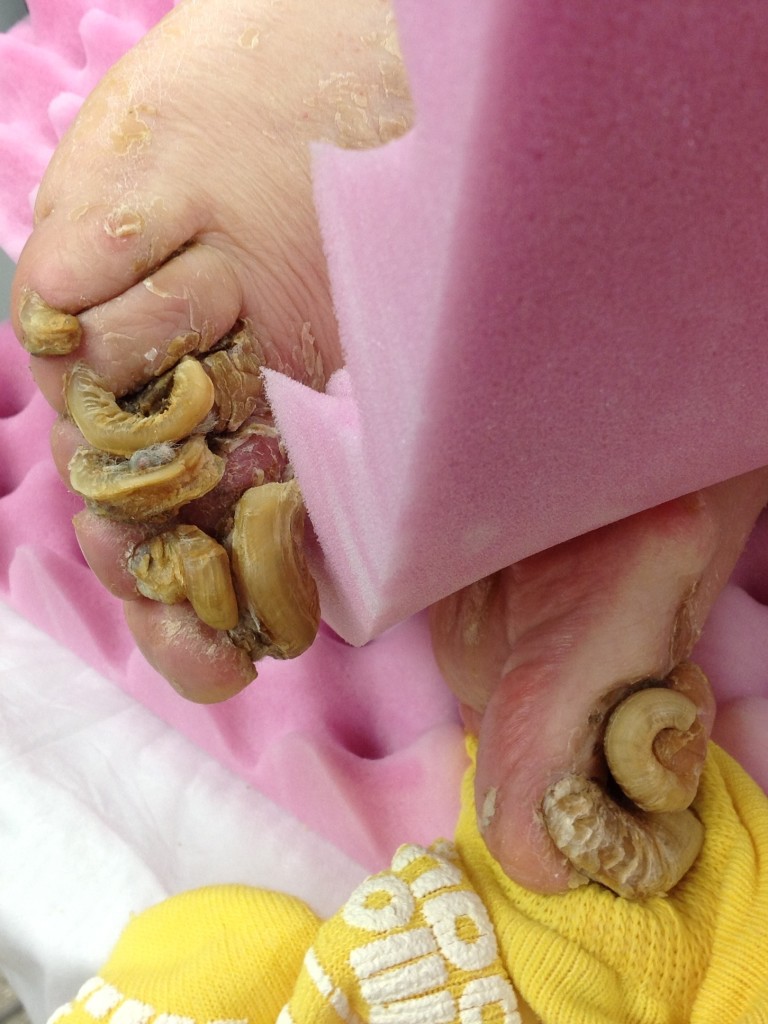
“Onychogryphosis (2)” by DiverDave is licensed under CC BY-SA 4.0
#8 A Giant Congenital Melanocytic Nevus
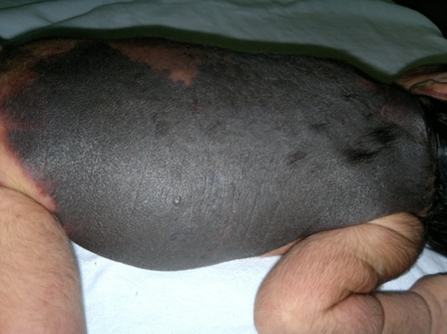
“Giant Congenital Melanocytic Nevus” by S. Sharma , N.L. Sharma, V. Sharma is licensed under GNU Free Documentation License, version 1.2
A giant congenital melanocytic nevus is a type of melanocytic nevus (also referred to as a mole) that is found in infants at birth. It is an extremely rare birthmark that only occurs in around 1% of infants worldwide. About 15% of the time, it is located in the head or neck area. Commonly, it will have the rare condition called hypertrichosis (abnormal amount of hair growth over the body).
Like the child in the above image, the largest forms are usually known as large or giant congenital melanocytic nevus. They are very rare and only occur in approximately 0.002% of births. As a child matures, the nevus can potentially alter in color. The surface may also be textured with growths that can spread rapidly. Unfortunately, a giant congenital nevi may have premalignant potential.
Treatment: For the removal of a giant congenital melanocytic nevus, a procedure involving a surgical excision (removed by cutting out) is performed. The removal may help prevent possible cancer. It can also relieve the psychosocial burden one would have with such an abnormal lesion.
#9 Harlequin-Type Ichthyosis
Harlequin-Type Ichthyosis is a skin disease where sufferers contain large, diamond-shaped scales throughout the body. The scales are a reddish color. The disease is the most severe form of congenital ichthyosis (family of skin disorders) and involves a thickening of the keratin layer in fetal human skin. Sufferers will possess severe cranial and facial deformities. There have been cases where Polydactyly (unusual number of fingers or toes) was found in infants with the condition.
Due to the scaly keratin, the child will have limited movement in the appendages, ears, eyes and penis. The scales are caused by severe hyperkeratosis (a thickening of the stratum corneum). The cracked skin increases the risk of a fatal infection. Due to skin not being suited to keep water in, patients will also often suffer from dehydration. The harlequin-type name was given because of the typical facial expression from patients and also from the diamond-shape of the scales that resemble the costume of Arlecchino (comic servant character from the Italian Commedia dell’arte).
Treatment: In the past, patients would typically survive for only a few days. They would usually die of systemic infection, but also other conditions such as dehydration and restricted breathing. Today, retinoids (such as Isotrex) have helped improve treatment and increased the lifespan of patients. In fact, the oldest known survivor has been suffering with the skin disorder since 1984.
#10 Ichthyosis Hystrix
Ichthyosis hystrix is a group of extremely rare skin disorders. The disorders are characterized by very large hyperkeratosis that give an appearance of spike-like scales (similar to a porcupine).
The above portrait shows a man that had suffered with Ichthyosis hystrix gravior (or porcupine man). Nearly the entire body was covered with spiny scales (except the face, palms, soles and genitals). The Englishman named Edward Lambert is one of the only few known cases (other than the three generations of his descendants). Lambert had earned the nickname “porcupine man”.
Treatment: We found no information on the treatments used for Lambert and his descendants.
If you like this post, you will also want to check out our recent article titled: 6 People With Horns.
More Bizarre Skin Conditions
The Conclusion
It is too bad that these people have to suffer with such terrible skin diseases. It not only causes them pain and suffering, but can also cause them to want to hide from the world because of their obvious differences. Luckily, there are surgical techniques available to help treat some of the cases.
Do you know of any other types of weird skin diseases you want to share? Sadly, there are many out there. There are still many conditions we don’t even know much about. However, science is always advancing. Hopefully there will not only be more treatments in the future, but also cures.
